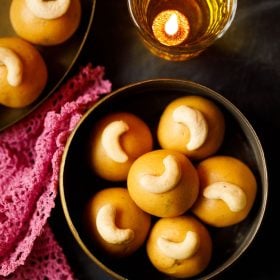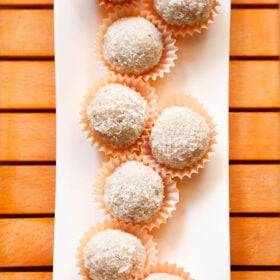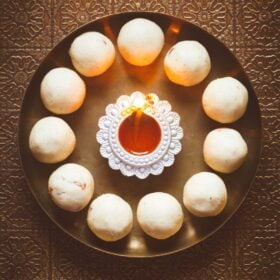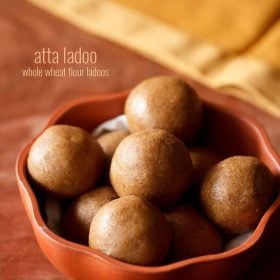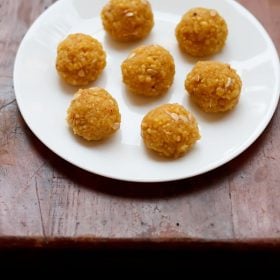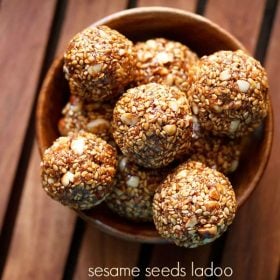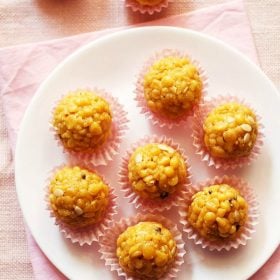Boondi Laddu are sweet spherical treats made by combining lovely little bits of fried and sugar-soaked batter (made with gram flour/besan) with seeds and fragrant spices. Each bite is a delightful blend of smooth, soft, and melt-in-the mouth for a snack or dessert you can’t get enough of! Here I share step-by-step photos and instructions to make a classic halwai style boondi ladoo recipe. I also share some steps on how to make Tirupati Laddu.
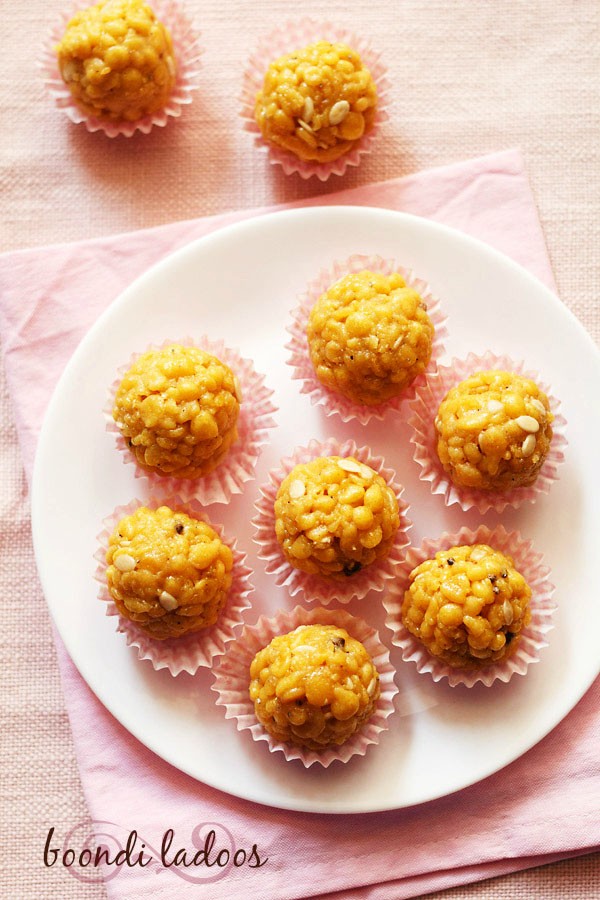
About Boondi Laddu Recipe
Laddu, or ladoo, are popular Indian treats often enjoyed during holidays and festivals, or just about any time there is an occasion to celebrate.
They are round ball-shaped sweet snacks that are made with all kinds of ingredients and preparation methods. It’s hard to pick just one to call a favorite!
The recipe I’m sharing with you today is for a soft boondi laddu made halwai style or similar to the ones you get in Indian sweet shops or mithai stores.
It’s similar to making Motichoor Ladoo. In Hindi boond means ‘droplets’ and here references the method used to make the base of the laddu.
Table of Contents
A thin gram flour (besan) batter is poured through a perforated flat ladle or sieve (or boondi ladle!) over a hot skillet of oil.
The batter droplets fall into the oil and quickly fry into crispy little balls, which are then added to a hot sugar syrup.
A variety of yummy seeds and seasonings are mixed in and the entire blend is shaped into the traditional round shape.
And although boondi ladoo do tend to take a bit of time and attentiveness to make, you’ll agree that they are worth every ounce of effort!
How to Make Boondi Laddu
Make Batter
1. First, add 1.5 cups besan (gram flour) and 2 pinches of crushed saffron or saffron powder to a mixing bowl.
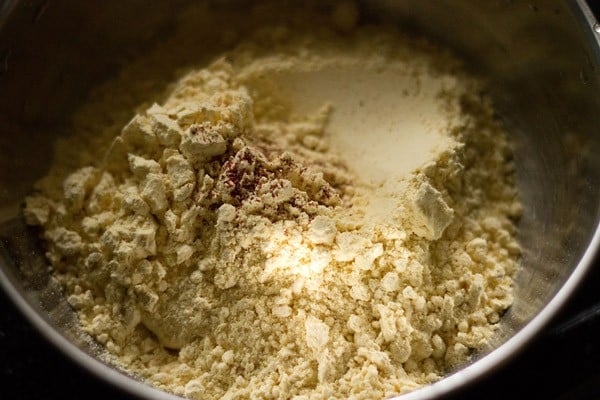
2. Add 1 cup + 1 tablespoon water and whisk to make a smooth batter without any lumps.
The consistency of the batter is important, so check if the consistency is right by frying a few boondis in the hot oil.
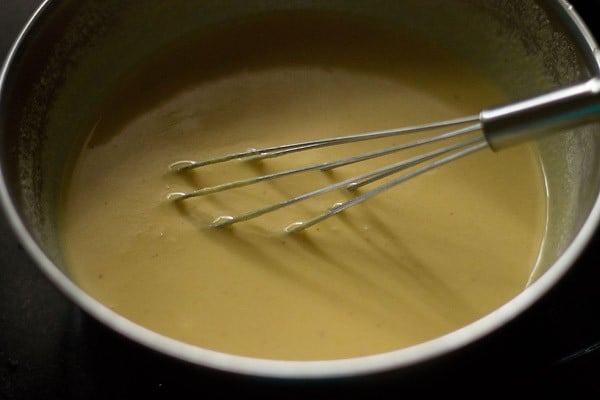
Test Batter Consistency
3. To test the batter: Tap the wired whisk or the handle of a spoon which has a bit of batter into the hot oil.
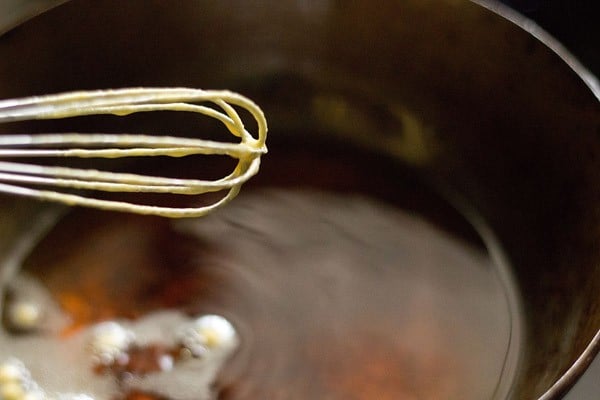
4. The boondis should have a round shape.
TIP 1: If they become flat, the batter is thin. To correct the consistency, add a bit of gram flour and check by frying a few boondi if too thin.
TIP 2: If the boondi are thick and if they get tail ends, the batter is thick. Then add a bit of water and then do the same test. Once you get the correct consistency, proceed with the next step of frying the boondi.
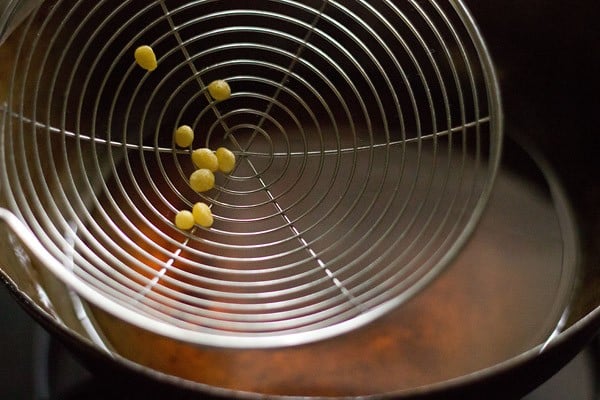
Make Sugar Syrup
5. Next, mix 1.5 cups sugar and ¾ cup water in a pan to make the sugar syrup.
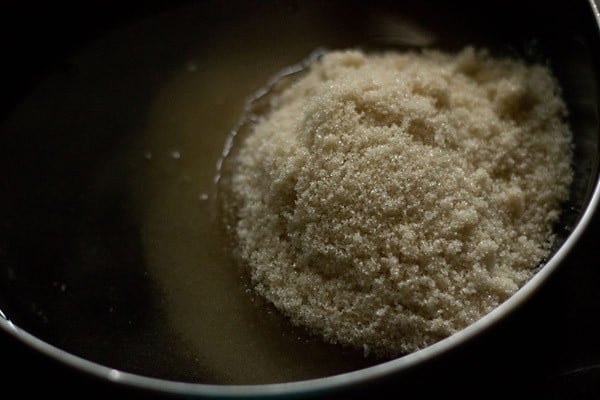
6. Gently bring the sugar solution to a simmer on low heat.
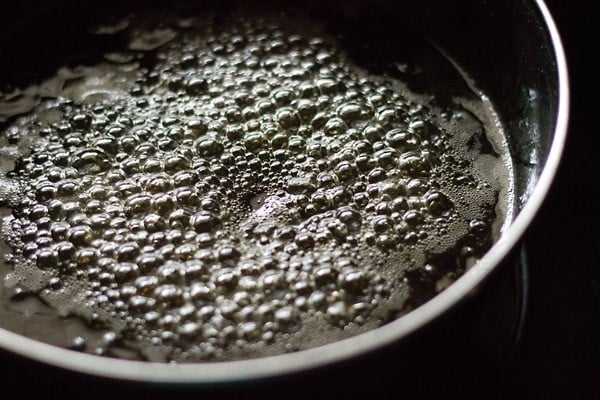
7. Cook the sugar syrup, stirring frequently, until you get a one thread consistency. Switch off the heat. Keep the sugar solution aside.
Note that the sugar syrup should be hot when you add the boondi. So you can keep the sugar solution on a hot water bath by placing the pan on a plate or tray filled with hot water.
How to check sugar syup consistency?
The sugar syrup will be very hot when you check the consistency. So take it in a small spoon or add a few drops on a plate and let it cool a bit for a few seconds.
When the heat is fine to handle, check the consistency by touching the syrup between your thumb and forefinger. You should see one string forming when you touch first and then pull your fingers apart.
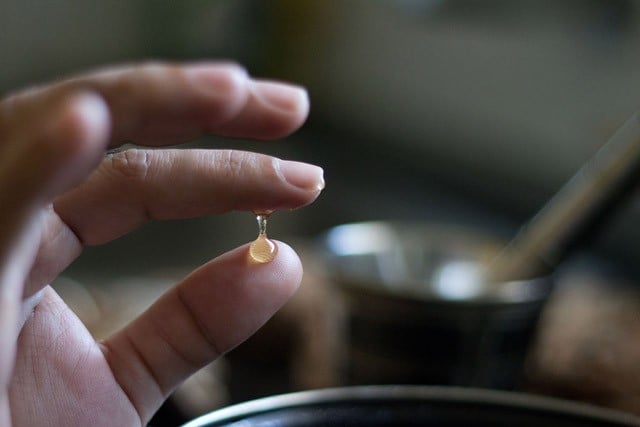
Fry Boondi
8. You can fry the boondi and prepare the sugar solution side by side. (That’s what I did!).
Take a dry perforated ladle with round holes (jhara) and place it above the hot oil. Hold the ladle only a couple of inches from the top of the oil to ensure that the droplets properly form to a round shape.
Note: If you use a regular slotted spoon, then you won’t get round shaped boondis. Also keep in mind to use a flat slotted spoon with round holes or the special boondi ladle!
When you add the batter and spread it, the first batch gives a round boondi. So you need to wipe the ladle every-time after spreading the batter.
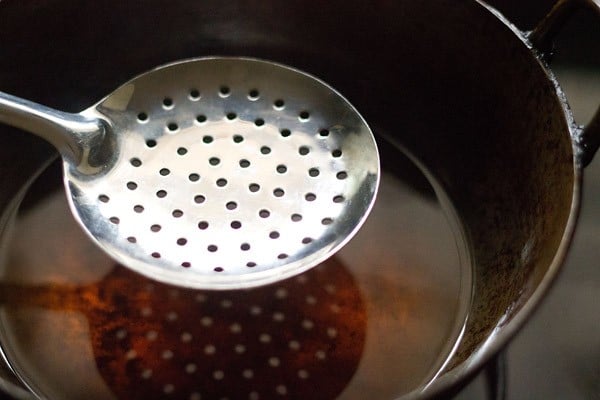
9. Use a spoon to add some batter on the perforated spoon ladle/jhara.
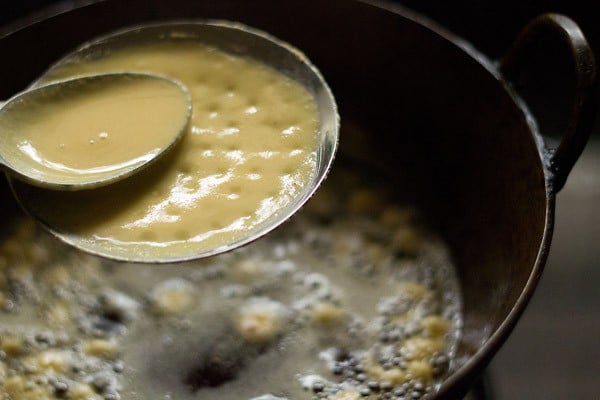
10. Spread the batter lightly with a spoon. Finish up the batter on the perforated spoon ladle this way.
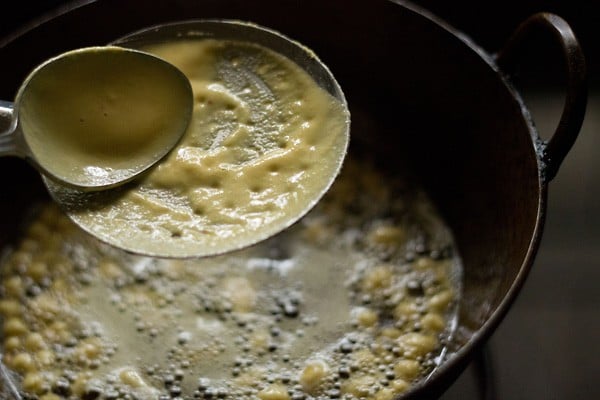
11. Fry the boondi until they are cooked golden. Don’t make them crisp or overdo the frying. When the oil stops sizzling, remove the boondi.
This step is also important because if boondi becomes crisp then the ladoo won’t be soft and they won’t be able to absorb the sugar syrup.
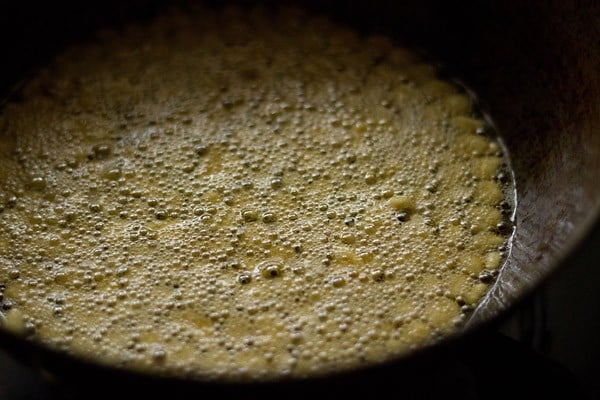
12. After each batch, wipe the perforated ladle/jhara with a clean piece of thin cotton kitchen towel from both sides.
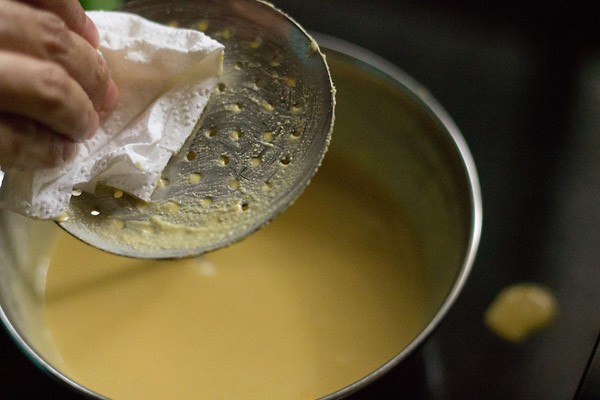
Make Boondi Laddu
13. Strain the boondi well with a slotted spoon draining all the oil in the pan or kadai and then add them directly to the hot sugar syrup. Fry all the boondi with the above method and then add them to the sugar syrup.
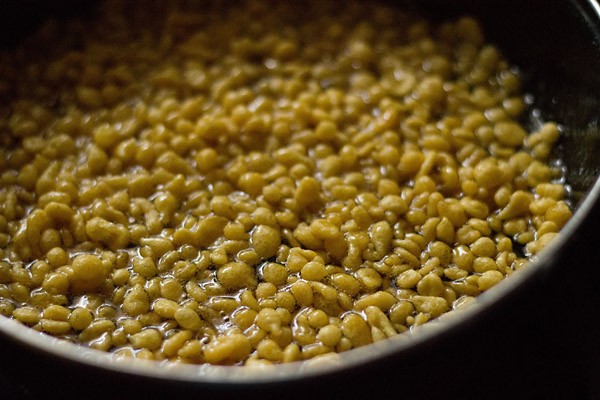
14. Finally add the following ingredients:
- 1 tablespoon melon seeds (magaz)
- ½ teaspoon cardamom powder
- black cardamon seeds (from 2 black cardamoms)
- 1 pinch of edible camphor (optional)
- 1 tablespoon ghee to help in binding the boondi ladoo
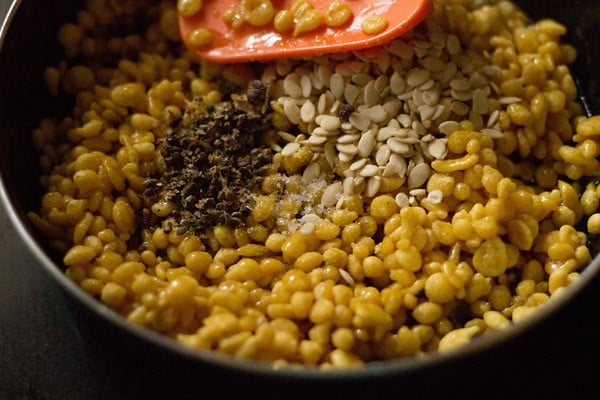
15. Mix well. The boondi will absorb all of the sugar syrup and you won’t find any liquids in this mixture.
When the mixture is warm or at room temperature, then use clean hands to shape the boondi mixture into a round laddu.
Spread some ghee on your palms while rolling and forming the laddu to keep the mixture from sticking on your palms.
If you are not able to shape them, then add 1 to 2 tablespoons more ghee as it helps in binding the laddu.
The boondi ladoo can be small to medium-sized. You can even make them large-sized if you want.
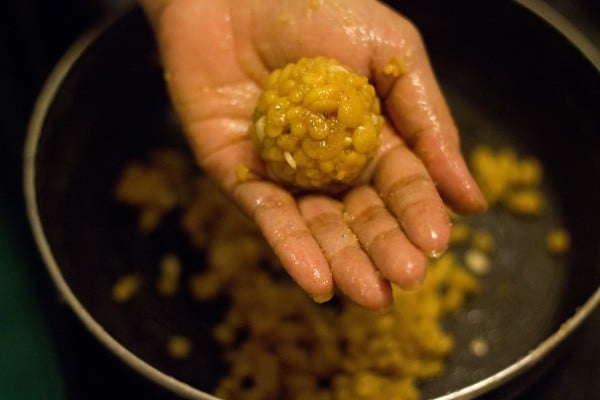
14. Serve on a plate together or place the boondi ladoo in individual muffin liners. If not serving the same day, refrigerate the boondi ladoo in an airtight container. These ladoo keep well for about a week in the fridge.
Note 1: If preparing for religious festivals and you want to make as food for deities, then please refrain from tasting or smelling the laddu. Also make it with a lot of devotion, cleanliness and a peaceful state of mind.
How to Make Tirupati Laddu
Easily adapt this recipe to make Tirupati Laddu. For those who do not know, the boondi laddu offered as prasad in the Venkateswara Temple in Tirupati is known as Tirupati Laddu. They are offered to the devotees and also sold so that the devotees can take them home to share them with their family, relatives or friends.
You only need to customize this recipe slightly to make Tirupati Laddu. Make the following changes:
- Firstly fry the boondi in desi ghee and not oil. I would recommend to use homemade ghee or a good quality ghee.
- Next fry the nuts and dry fruits in ghee until golden. I suggest to add cashews and raisins. Fry the raisins until they swell and plump in the ghee. Fry the cashews till they are golden. Halve or chop cashews before you fry them. Later add these fried dry fruits to the boondi laddu mixture.
- Do not add black cardamom seeds and melon seeds. You can choose to add saffron or skip it.
- You can also opt to add 1 to 2 teaspoons of rock sugar (mishri, kalkandu) to the laddu mixture. Crush the rock sugar pieces to a semi-fine powder using a mortar-pestle and add when you add the cardamom powder
- Also ensure to add edible camphor to the laddu mixture for that lovely and unique camphor aroma which is a trademark flavor of the Tirupati Laddu.
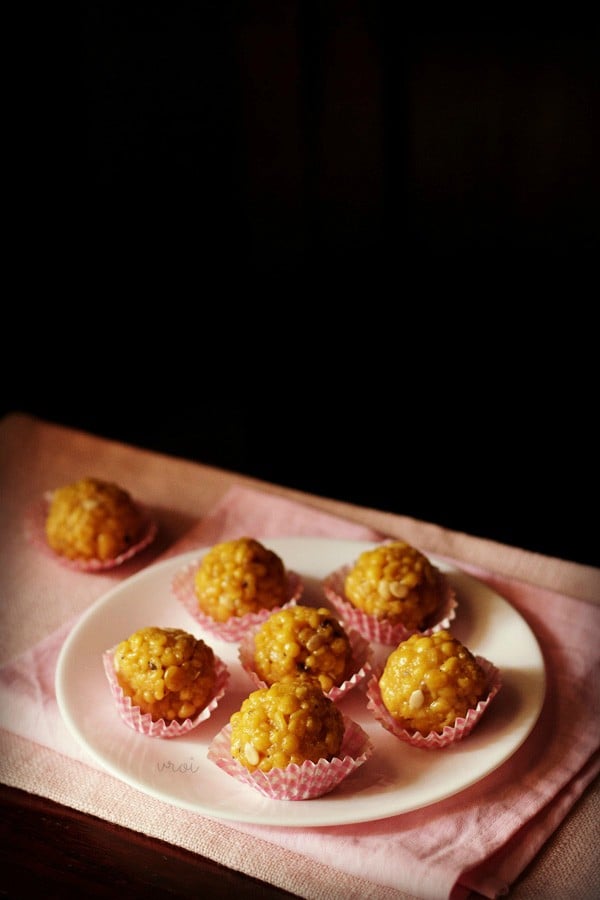
FAQs
Along with the seeds and spices, feel free to add raisins or other dried fruit and/or chopped cashews.
These treats will keep well for a few days in a sealed container at room temperature. For longer storage keep them in an airtight container in the refrigerator for up to a week.
The recipe as-is will make approximately 10 to 12 ladoo. With the amount of effort needed to make boondi laddu I do recommend you make at least a full amount. But yes you absolutely can double or triple the recipe and work in batches for large celebrations.
More Ladoo Varieties To Try!
Ladoo Recipes
Ladoo Recipes
Ladoo Recipes
Please be sure to rate the recipe in the recipe card or leave a comment below if you have made it. For more vegetarian inspirations, Sign Up for my emails or follow me on Instagram, Youtube, Facebook, Pinterest or Twitter.
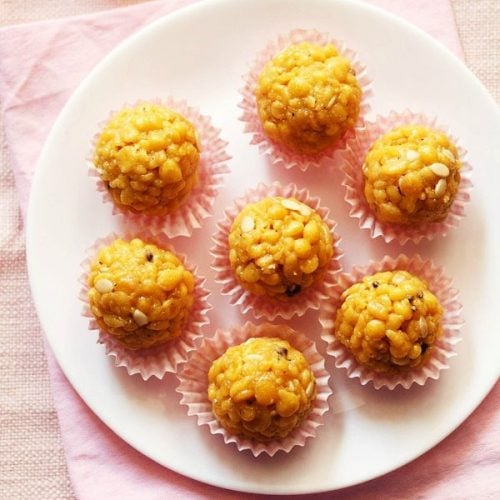
Boondi Laddu Recipe (Halwai Style)
Ingredients
For the sugar syrup
- 1.5 cups sugar
- ¾ cup water
For batter
- 1.5 cups gram flour (besan)
- 1 cup + 1 tablespoon water or add as required – the amount of water to be added depends on the quality of besan
- 2 pinches crushed saffron strands or saffron powder
- ½ teaspoon cardamom powder or 5 to 6 green cardamoms crushed to powder in a mortar-pestle
- 1 tablespoon melon seeds (magaz)
- 2 black cardamoms – seeds kept and the husks discarded
- 1 pinch edible camphor – optional
- 1 tablespoon ghee and some more ghee for applying on your palms while shaping the laddu
- oil for deep frying, as required
Instructions
Making sugar syrup
- Mix sugar and water in a pan. Keep the sugar solution on stove top on a low heat.
- Cook the sugar syrup, till you get a one thread consistency. Stir often. Switch off the heat. Set the sugar solution aside.
- The sugar syrup should be hot when you add the boondi. So you can keep the sugar solution on a hot water bath by place the pan on a plate or tray filled with hot water. You can choose to fry the boondi and prepare the sugar solution side by side.
Making and frying boondi
- Take the dry ingredients for the boondi batter in a mixing bowl – gram flour and crushed saffron or saffron powder.
- Add water to make a smooth batter. The consistency of the batter is important. We will check if the consistency is right, by frying a few boondis.
- Tap the wired whisk or the handle of a spoon which has a bit of batter in to the hot oil. The boondis should have a round shape.
- If they become flat, the batter is thin and if they get tail ends, the batter is thick.TIP 1: If thin, then add a bit of gram flour and check by frying a few boondi. TIP 2: If thick, then add a bit of water and then do the same test. Once you get the correct consistency, proceed with the next step of frying the boondi.
- Take a dry perforated ladle and place it above the hot oil. Don't keep the ladle too much on a height, as the batter droplets, when falling from a height, do not give a round shape.
- With a spoon add some batter on the perforated spoon ladle.
- Spread the batter lightly with a spoon. Finish up the batter on the perforated spoon ladle this way.
- Fry the boondi till they are cooked. Don't make them crisp or over do the frying. When the oil stops sizzling, remove the boondi.
- This step is also important because if boondi becomes crisp then the boondi ladoo won’t be soft and they won’t be able to absorb the sugar syrup.
- After each batch, wipe the perforated ladle with a clean piece of kitchen towel from both sides.
Making Boondi Laddu
- Strain the fried boondi well with a slotted spoon and then add them directly to the hot sugar syrup. Fry all the boondi in batches with the above method and then add them to the sugar syrup.
- Finally add melon seeds (magaz), cardamom powder, black cardamon seeds, ghee and a pinch of edible camphor (optional).
- Mix well and shape the boondi mixture into a small to medium-sized round spherical ball. If you are not able to shape them, then add 1 to 2 tablespoon more ghee as it helps in binding.
- You can place the boondi ladoo in a small muffin liners. You can also garnish them with raisins or cashews or slivered nuts like almonds or pistachios.
- Serve boondi laddu. If not serving the same day, refrigerate them in an airtight container. These laddu keep well for about a week in the fridge.
Notes
Nutrition Info (Approximate Values)
Boondi Laddu recipe from the archives was first published on August 2014.
